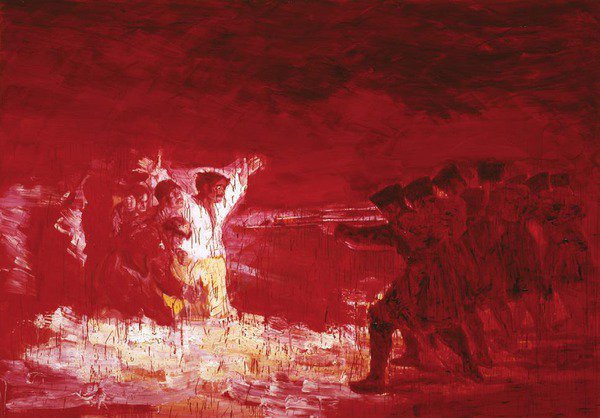Yan Pei-Ming
dal 3/5/2012 al 22/6/2012
Segnalato da
3/5/2012
Yan Pei-Ming
David Zwirner, New York
Ming's subjects, which range from historical figures, political leaders and the artist himself, are typically presented face-on, with bold and expressive brushwork. The artist's fluid yet precise technique and his use of shallow pictorial space combine to create iconic monumental, and psychologically charged works.

David Zwirner is pleased to present an exhibition of
recent work by Yan Pei-Ming, on view at the gallery’s
519 West 19th Street space. Born in Shanghai in 1960 and
based in Dijon, France, Ming has gained international
recognition for his large-sized, monochromatic portraits.
His subjects, which range from historical figures, political
leaders, and celebrities to anonymous soldiers, serial
killers, female prisoners, orphans, and the artist himself,
are typically presented face-on, with bold and expressive
brushwork. The artist’s fluid yet precise technique and his
use of shallow pictorial space combine to create iconic, monumental, and psychologically charged works.
The paintings in this exhibition, Ming’s second at the gallery, relate to events in the recent and distant past. In a
departure from previous work by the artist, they extend beyond the depiction of a singular subject to reference broad
historical issues and, in the process, the gap that exists between the events and their visualization. Often taking a
combination of mass media imagery and his own recollections of a motif as his starting point, Ming thus broadens a
traditional understanding of the medium of painting: he refers to his large-scale canvases as “collages” of photographs
and memories, while medium-specificity is further cast into question by the fluidity of the artist’s painterly technique,
which at times resembles watercolor.
Black Paintings is a title derived from a late series of wall paintings by Francisco Goya, since transferred to canvas. In
these works, not originally intended for public view, the Spanish artist offers haunting visions of humanity’s darker side.
Among the paintings on view in the present exhibition, one refers directly to a work by Goya. Exécution, Après Goya
(2008) offers an interpretation of The Third of May 1808 (1814), which depicts the execution by firing squad of Spanish
civilians who had taken part in an uprising against the French occupation of their country. Using blood red paint and
bold brushstrokes with visible drips, Ming’s version of the subject matter dramatically isolates the figures from any
background, thus separating the action from its historical context. The painting is the only one in the exhibition to use
a color that is not black, white, or gray.
Also on view is Pablo (2011), which shows a young Pablo Picasso kneeling before an unknown object or presence.
The background is indeterminate and dark, and again provides no contextual setting. A somber, if ambiguous, mood
is intensified by the boy’s downward gaze and the impossibility of telling whether his awkward pose is indicative of
a religious act or perhaps signifies a punitive measure about to take place. By depicting arguably the most famous
painter of the modern era as a humbled adolescent, Ming’s painting includes a reference to its own medium, while its
black-and-white palette underscores a sense of nostalgia.
A more recent history is evoked in Invisible Women (2011), a multiple portrait of burka-clad women. Standing closely
together in a large group and looking straight ahead, the many pairs of eyes have a hypnotic quality and form a
disquieting horizon. The subject matter may be a reference to the democratic undercurrents of the Arab Spring, which
has led to an increased focus on women’s rights in the region. Although the title is borrowed from H.G. Wells’s famous
novel The Invisible Man (1897), which told the story of a scientist whose experiments made him an invisible murderer,
the women portrayed by Ming each have identifiable characteristics despite revealing little flesh.
While the historical significance of Ming’s chosen subjects is readily apparent, his works resist the traditional heroic
connotations of history paintings. The artist’s aforementioned reliance on often blurry mass media source material and
personal memory combine to present a sense of elusiveness that is underscored by exaggerated brushwork. Rather
than documenting separate events, the paintings suggest an ongoing history in flux.
Yan Pei-Ming joined David Zwirner in 2006 and had his first New York solo exhibition at the gallery the following year.
Over the past decade, the artist has had solo exhibitions at the Ullens Center for Contemporary Art, Beijing; Musée du
Louvre, Paris; San Francisco Art Institute (all 2009); Musée d’art moderne de Saint-Étienne Métropole, Saint-Étienne,
France (2006); Shanghai Art Museum; Guangdong Museum of Art, Guangzhou, China (both 2005); Kunsthalle Mannheim,
Germany (2004); Musée des Beaux-Arts, Dijon, France; Musée des Beaux-Arts et d’Archéologie, Besançon, France; and
the Musée d’Art et d’Histoire, Geneva (all 2003).
Ming’s work was featured in several group exhibitions in 2011, including the Fonds régional d’art contemporain
Auvergne, Clermont-Ferrand, France; Musée Anne-de-Beaujeu, Moulins, France; and the Musée des beaux-arts de
Dôle, Dôle, France. He participated in the French Pavilion for Expo 2010 in Shanghai and other international group
exhibitions include the Istanbul Biennial (2007); 2nd Seville Biennale, Spain (2006); Venice Biennale (2003 and 1995); and
the Lyon Biennale, France (2000 and 1997).
Work by the artist is represented in museum collections worldwide, including the Centre Georges Pompidou, Paris;
Kunsthalle Mannheim, Germany; Musée d’Art Moderne de la Ville de Paris; Musée des Beaux-Arts, Dijon, France;
Museum Ludwig, Cologne; National Museum of Modern Art, Tokyo; and the Shanghai Art Museum.
Opening reception: Friday, May 4, 6 – 8 PM
Press preview with the artist: 10:30 AM
David Zwirner
525 West 19th Street - New York
Hours: 10am to 6pm Tuesday – Saturday
Monday, by appointment
Free admission



